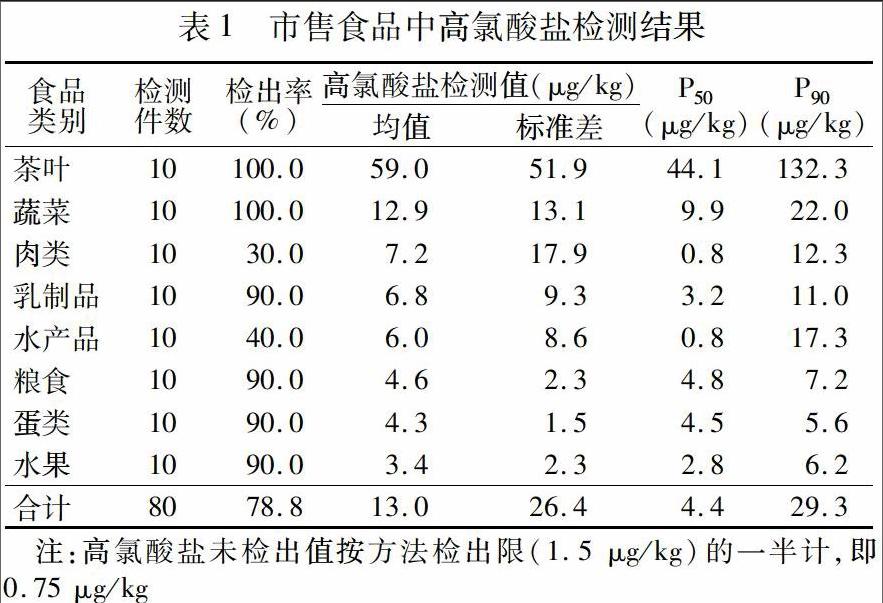上海市市售食品中高氯酸盐污染的暴露评估
宇盛好+李亦奇+张旭晟+张露菁+彭少杰



摘要
目的:为了解食品中高氯酸盐的污染水平和健康风险,为食品中高氯酸盐的标准制定和风险管理提供参考。方法:开展上海市市售食品中高氯酸盐风险监测,结合居民食物消费量调查结果,运用概率评估法对食品中高氯酸盐进行暴露评估。结果:共监测市售粮食、蔬菜、水果、乳制品、肉类、蛋类、水产品和茶叶等8类食品80件样品,高氯酸盐检出率为78.8%,平均检测值13.0±26.4 μg/kg。其中,茶叶中高氯酸盐检测平均值最高,为59.0±51.9 μg/kg,水果中高氯酸盐检测平均值最低,为3.4±2.3 μg/kg。以最大健康保护为原则,若食品中高氯酸盐在加工烹调过程中均不损失,则本市普通居民通过上述8类食品的高氯酸盐平均暴露量为0.25 μg/kg bw体质量/day,高消费人群的暴露量(P95)为0.44 μg/kg bw体质量/day,已超過2015年欧洲食品安全局(EFSA)设置的高氯酸盐每日容许摄入量(TDI)(0.3 μg/kg bw体质量/day),存在一定的健康风险。结论:由于高氯酸盐具有较高的水溶性,其在食品烹调加工中会有一定降解,需要进一步开展实际暴露量研究。
关键词:食品;高氯酸盐;每日容许摄入量;暴露评估
Exposure Asessment of Perchlorate Pollution from Food in Shanghai Residents
YU Sheng-hao1, LI Yi-qi1, ZHANG Xu-sheng1, ZHANG Lu-jing1, PENG Shao-jie1,*,
(Shanghai Center for Adverse Drug and Medical Device Reaction Monitoring, Shanghai 200040)
Abstract
Objects: This paper aimed to provide scientific evidences on regulation establishment and risk management of perchlorate contaminants in food based on investigations of perchlorate contamination levels in foods and relevant hazard outcomes. Methods: The exposure assessment on the presence of perchlorate in food was performed by probability assessment approach, with datasets from food monitoring program and food consumption study in Shanghai. Results: 80 food samples from 8 food categories, including grain, vegetables, fruits, dairy products, meat, eggs, aquatic products and tea, were analyzed and the presence of perchlorate rate was 78.8% with a mean value at 13.0±26.4 μg/kg. The highest mean value of perchlorates was 59.0±51.9 μg/kg in tea, and the lowest mean value was 3.4±2.3 μg/kg in fruits. Based on the maximum level of protection of human life and health (i.e., losses of perchlorate during the processing were not taken into account), the average estimated dietary intake of perchlorate from the 8 food categories was 0.25 μg/kg bw体质量/day. However, the 95 percentile exposure estimates reached up to 0.44 μg/kg bw体质量/day, which exceeded the tolerable daily intake (TDI) value established by European Food Safety Authority (EFSA) for healthy adults at 0.3 μg/kg bw体质量/day. Therefore, potential health risk may exist to certain groups of people. Conclusions: Due to the high water-solubility of perchlorates, losses of perchlorates in food probably occur during processe of cooking. Further investigations on this topic were highly recommended.
Keywords:food; perchlorate; tolerable daily intake; exposure assessment
高氯酸盐是一种持久性化学污染物,在正常环境条件下可存在数十年[1,2]。高氯酸盐的污染主要来源于人类的大量生产和使用。自20世纪40年代以来,人们将高氯酸盐应用于火箭与导弹的固体推进剂、航天器材、军火、烟花爆竹、纺织物固定剂、电镀、橡胶制品、涂料、冶炼、机动车安全气囊和镁电池等产品的生产领域[3-5]。高氯酸盐易溶于水,可污染地下水、地表水及饮用水水源,也可经过土壤和水被植物所吸收并进一步富集[6-9]。环境中高氯酸盐可通过饮水、呼吸、或经食物链以不同途径进入人体,其中饮食是人体摄入高氯酸盐的主要途径[10-11]。研究显示,高氯酸盐的分子结构与碘分子的结构形状非常相似,可与甲状腺中的碘和母乳中的碘竞争吸收,干扰甲状腺素的合成和分泌,从而影响人体正常的新陈代谢,阻碍人体正常的生长和发育,尤其是对生长发育期儿童的影响尤为严重。一旦婴幼儿体内的高氯酸盐过量,会出现智商偏低、学习障碍、发育迟缓、多动症、注意力分散、甚至弱智等症状[8,12]。

